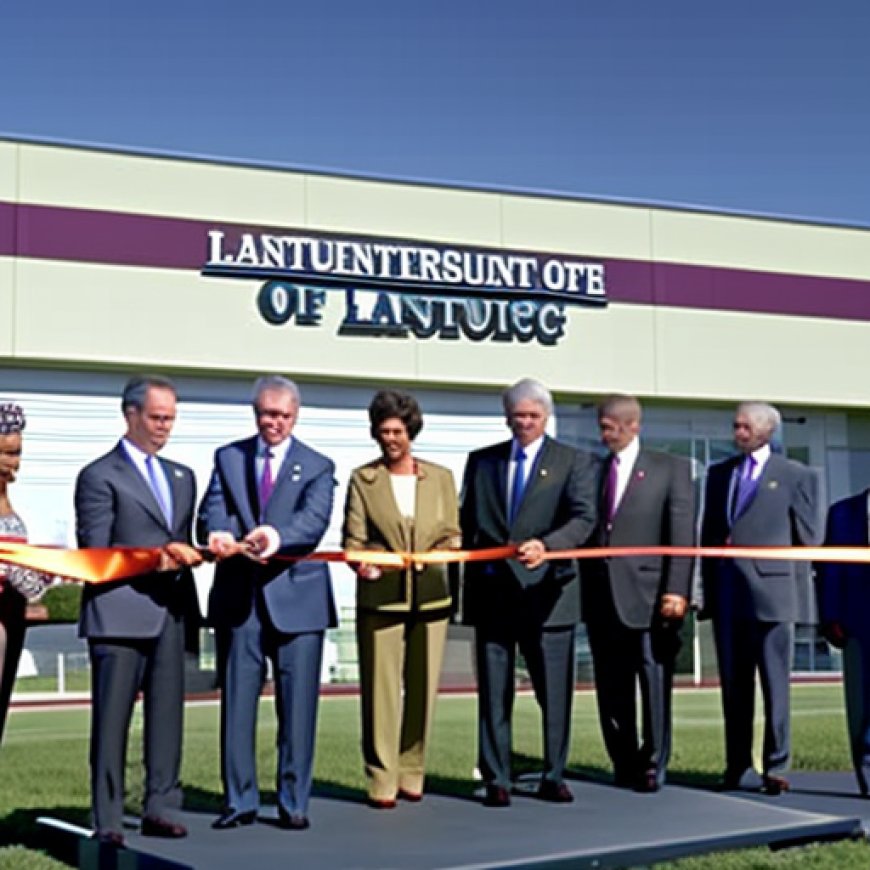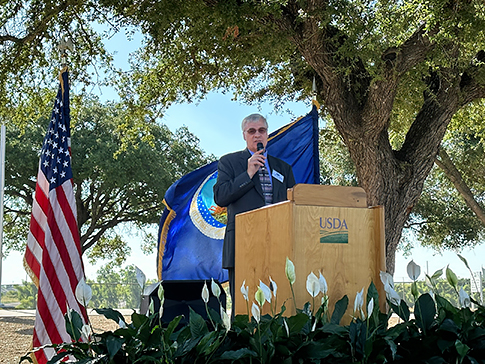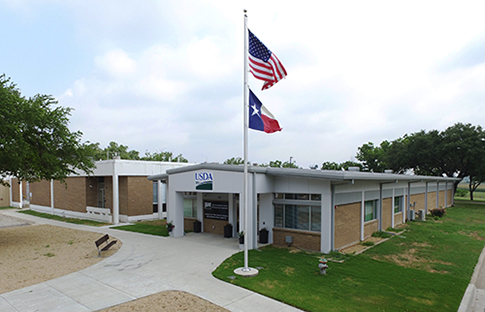U.S. Department of Agriculture Holds a Ribbon Cutting Ceremony for the Opening of a New Laboratory Building in Texas : USDA ARS
U.S. Department of Agriculture Holds a Ribbon Cutting Ceremony ... Agricultural Research


U.S. Department of Agriculture Holds a Ribbon Cutting Ceremony for the Opening of a New Laboratory Building in Texas
Contact: Maribel Alonso
Email: Maribel.Alonso@usda.gov
TEMPLE, TEXAS, August 3, 2023
The USDA’s Agricultural Research Service (ARS), Grassland, Soil, and Water Research Laboratory, today held a dedication and ribbon cutting for the opening of a newly renovated laboratory building that will allow scientists to continue their mission of developing solutions for more efficient use of soil and water resources, enhancing forage and crop production, and supporting sustainable agricultural production in healthy ecosystems by utilizing modern technology.
This event celebrated past, present, and future cooperative research between USDA-ARS, USDA-Natural Resources Conservation Service (NRCS), and Texas A&M AgriLife.
The ceremony opened with remarks from leaders emphasizing the significance of the construction project, which allowed for the modernization of the existing Grassland, Soil, and Water Research Laboratory, originally built in 1976.
Dr. Steven Kappes, ARS National Program associate director, spoke about the laboratory history of working on solutions for regenerative agriculture movements and addressing challenges faced by various agricultural industries. The new laboratory is expected to continue this work.
“We are very excited to celebrate the completion of the modernized Grassland, Soil, and Water Research Laboratory research facility to improve the safety and efficiency of our research and enhance collaborations with our long-term partners, NRCS and Texas A&M AgriLife,” said Dr. Kappes. “This facility will be instrumental in building upon our 46-year research program to develop new and innovative methods and models to improve soil, water, crops, and rangeland management techniques in changing climates.”
 Dr. Steven Kappes, ARS Associate Administrator, kicks off USDA-ARS ribbon cutting ceremony for the newly-renovated ARS Grassland, Soil & Water Research Laboratory in Temple, Texas.
Dr. Steven Kappes, ARS Associate Administrator, kicks off USDA-ARS ribbon cutting ceremony for the newly-renovated ARS Grassland, Soil & Water Research Laboratory in Temple, Texas.
Others in attendance included U.S. Representative John Carter, Temple Mayor Tim Davis, ARS Plains Area Director Dr. Larry Chandler, and ARS Laboratory Research Leader Dr. Douglas Smith.
“The Grassland, Soil and Water Research Laboratory is one of the preeminent centers for natural resource model development, a program which now has a global impact, and the water quality dataset at the facility offers one of the richest datasets on environmental outcomes from agricultural conservation,” said Dr. Smith with the Grassland, Soil and Water Research Laboratory.
“The modernization project has been a long process, and we are excited to have our facility ready to meet the research needs to support agricultural producers and decision-makers for many decades to come.”
The Grassland, Soil, and Water Research Laboratory was established in 1929, sharing a location with USDA scientists from the Division of Chemistry and Soils at the Texas A&M AgriLife Blackland Research and Extension Center. The initial objective was to develop tools and technologies to assist farmers in the Texas Blackland Prairie. The research expanded to address the region’s highly erodible soils, which were causing significant losses for producers and farmers in the region, particularly during the Dustbowl in the 1930s. Scientists focused on creating conservation practices to reduce erosion.
Over the years of research, Grassland, Soil and Water Research Laboratory scientists evaluated terraces and grassed waterways in various sites, including the Blackland Prairie, collecting more than 80 years of data. The data have contributed to the development of initial empirical models for evaluating the role of agriculture in water quality through erosion. These models have been continuously improved and now serve as the primary mechanisms to evaluate the environmental outcomes of agricultural conservation policy.
 The Grassland, Soil, and Water Research Laboratory in Temple, TX
The Grassland, Soil, and Water Research Laboratory in Temple, TX
The new laboratory will focus on the following research projects:
- Enhancing decision support tools for crop and forage production and watershed management.
- Develop improved soil, water, and crop management techniques.
- Develop sustainable crop, forage, and biofuel production systems.
- Increase rangeland productivity and quality.
- Mitigate global change effects on agriculture.
The USDA-NRCS and Texas A&M AgriLife will be sharing laboratory and office space with ARS researchers. This collaboration in research will bring benefits to growers, commodity groups, agricultural businesses, and U.S. consumers who count on this partnership to discover solutions to agricultural and environmental issues.
The Agricultural Research Service is the U.S. Department of Agriculture’s chief scientific in-house research agency. Daily, ARS focuses on solutions to agricultural problems affecting America. Each dollar invested in U.S. agricultural research results in $20 of economic impact.
SDGs, Targets, and Indicators
1. Which SDGs are addressed or connected to the issues highlighted in the article?
- SDG 2: Zero Hunger
- SDG 6: Clean Water and Sanitation
- SDG 13: Climate Action
2. What specific targets under those SDGs can be identified based on the article’s content?
- SDG 2.4: By 2030, ensure sustainable food production systems and implement resilient agricultural practices that increase productivity and production, that help maintain ecosystems, that strengthen capacity for adaptation to climate change, extreme weather, drought, flooding, and other disasters, and that progressively improve land and soil quality.
- SDG 6.4: By 2030, substantially increase water-use efficiency across all sectors and ensure sustainable withdrawals and supply of freshwater to address water scarcity and substantially reduce the number of people suffering from water scarcity.
- SDG 13.3: Improve education, awareness-raising, and human and institutional capacity on climate change mitigation, adaptation, impact reduction, and early warning.
3. Are there any indicators mentioned or implied in the article that can be used to measure progress towards the identified targets?
- Indicator for SDG 2.4: Adoption of sustainable agricultural practices, such as improved soil and water management techniques.
- Indicator for SDG 6.4: Water-use efficiency improvements in agriculture and research on sustainable water management practices.
- Indicator for SDG 13.3: Research and development of innovative methods and models to improve soil, water, crops, and rangeland management techniques in changing climates.
SDGs, Targets, and Indicators
| SDGs | Targets | Indicators |
|---|---|---|
| SDG 2: Zero Hunger | 2.4: By 2030, ensure sustainable food production systems and implement resilient agricultural practices that increase productivity and production, that help maintain ecosystems, that strengthen capacity for adaptation to climate change, extreme weather, drought, flooding, and other disasters, and that progressively improve land and soil quality. | Adoption of sustainable agricultural practices, such as improved soil and water management techniques. |
| SDG 6: Clean Water and Sanitation | 6.4: By 2030, substantially increase water-use efficiency across all sectors and ensure sustainable withdrawals and supply of freshwater to address water scarcity and substantially reduce the number of people suffering from water scarcity. | Water-use efficiency improvements in agriculture and research on sustainable water management practices. |
| SDG 13: Climate Action | 13.3: Improve education, awareness-raising, and human and institutional capacity on climate change mitigation, adaptation, impact reduction, and early warning. | Research and development of innovative methods and models to improve soil, water, crops, and rangeland management techniques in changing climates. |
Behold! This splendid article springs forth from the wellspring of knowledge, shaped by a wondrous proprietary AI technology that delved into a vast ocean of data, illuminating the path towards the Sustainable Development Goals. Remember that all rights are reserved by SDG Investors LLC, empowering us to champion progress together.
Source: ars.usda.gov

Join us, as fellow seekers of change, on a transformative journey at https://sdgtalks.ai/welcome, where you can become a member and actively contribute to shaping a brighter future.







